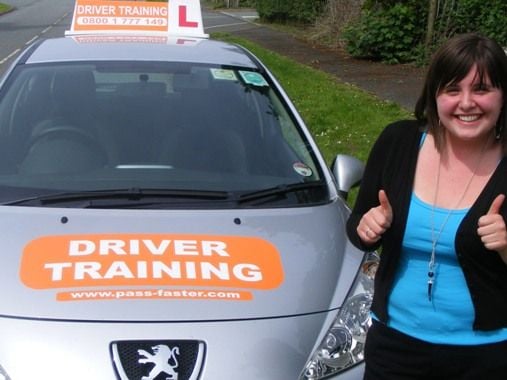Become A Driving Instructor - An Overview
Do you enjoy driving and would you like to get the satisfaction of teaching people new skills? If so, a career as an ADI (Approved Driving Instructor) could be the right choice for you
- Be your own boss
- Earn £25-£35 per hour
- Work the days and times that suit you
- New car every 12-18 months
- Work areas close to home
- Once qualified either stay with us or we help you set up on your own
- Career progression - once you qualify you can train for fleet training/trailer training/ORDIT training/Examiner training
- For those willing to put the work in, though, this can be a gratifying and financially rewarding career.
So, how do you make the leap from driver to qualifying as a driving instructor?
Well, it's quite a journey! Bad news: there will be some tests. Good news: it is totally worth it!!
adi online training
No matter where you are and no matter what lockdown or Tier restrictions you have, you can continue your ADI Part 3 training Online!
Sessions are 60, 90 or 120 minutes and just £35 PER HOUR!
CALL TO BOOK YOURS NOW 07791 152 046

Beware of Cheap Training Offers
BEWARE that Many national companies will reduce the training course cost, but also as part of it, tie you in to a 12 or 18 month franchise contract, instead of just setting yourself up as your own business – We help with that.
Or Paying per pupil (currently £30 per pupil)
Or like our franchise paying £70 per week, you are charged £159 or more per week (£89 difference per week! - £89 x 52 weeks = £4,658)
So they offer training at £800 - £1000 less – But then make you end up paying almost a minimum of £5000 extra!! Not really a good deal is it???
As long as you're 21 or over and have held a clean driving licence for at least 3 years, you can get started! Head to the government website and fill out the application to become a driving instructor. Once that's been approved, the qualification process can begin.
Being an ADI is a big responsibility in many ways, so you will need to jump through a few hoops before you get the official seal of approval (otherwise known as joining the ADI register). Don't be daunted by the length of the process—taken stage by stage, it's perfectly doable.
Part 1: Driving Theory
First off, it's time to show off your driving knowledge. This is very similar to the theory test you took as a learner, but with more questions and a stricter pass threshold. That means you need to read up on the Highway Code, traffic signs and general driving skills. There's also a hazard perception section—so make sure your reactions are on point!
Once you feel ready, it's just a case of keeping your cool on test day. You'll have 1 hour and 30 minutes to answer 100 multiple-choice questions. These are divided into 4 sections:
- Road procedure
- Traffic signs, control, pedestrians and mechanical knowledge
- Driving test, disabilities and the law
- Publications and instructional techniques
You must get at least 20 (out of 25) correct on each section.
After that, there are 14 video clips to watch, during which you should click every time you see a developing hazard. Each hazard can earn you up to 5 points, depending on how early you spot it.
Cost: £81
Pass Score: 85/100 (multiple-choice section) 57/75 (hazard perception)
Attempts Allowed: You have unlimited attempts to pass part 1 of the ADI tests
Part 2: Driving Ability
Now it's time to prove that you can drive like a pro. Again, this will be quite similar to the practical test you took as a learner. This time, however, you have to show not only that you can drive, but that you can drive at expert level. Be prepared to be tested on:
- Eyesight
- 'Show me, tell me' questions
- General driving ability
- 2 Manoeuvres
- Independent driving (following signs or sat nav)2
The test will last for at least 70 minutes, rather than 40 minutes (like the regular practical test). Plus, you'll have to answer 5 'show me, tell me' questions, rather than 2.
The rules are much stricter for ADIs, too. For example: failing a question on the 'show me, tell me' section will result in a minor fault; failing to answer any of the questions correctly counts as a major fault and so an overall fail on the test.
Cost: £111
Pass Score: No more than 6 driving faults (aka driving) faults and no major (aka serious or dangerous) faults.
Pass Rate 2017/18: 54.7%
Attempts Allowed: 3

ADI Part 3: Instructional Ability
You've impressed with your motor knowledge and shown that you can drive to a high standard, now you must demonstrate how you are able to pass these skills onto others. A DVSA examiner will observe you conducting a 1 hour lesson with a pupil.
The person you teach can be an actual learner, or someone who already has a licence.
Note that they cannot be another trainee ADI.
During this 'lesson' you will be marked on 17 areas (each with a possible score of 0-3 points), which are divided into 3 categories:
- Lesson planning
- Risk Management
- Teaching and learning strategies
For a full list of each of the 17 areas, check out the Part 3 test report form. The safety of learner drivers is obviously a high priority, so bear in mind that a score of 7 or less on the risk management category will result in an immediate fail.
On completing the test, you'll be told whether you've passed or failed. There are two different levels at which you can achieve a pass. Grade B—well done, you can get on the ADI register! Or Grade A—check you out! Not only are you allowed on the register, you've shown a particularly high standard of instruction. Permission to be slightly smug granted.
Cost: £111
Pass Score: 31-42 (Grade B); 43-51 (Grade A)
Pass Rate 2017/18: 36.7%
Attempts Allowed: 3
Once you pass part 3, you have 12 months to apply for your ADI badge. This is a certificate that means you're on the ADI register and thus legally allowed to charge money for teaching people to drive. It's the final hurdle to cross in order to start your new career.
...And it will cost you £300. If this is your calling, it's definitely worth the investment.
The National Careers Service estimates that driving instructors can expect to earn between £15,000 and £30,000 a year.

Training
As you can see, becoming a driving instructor takes a lot of work, so don't be afraid to reach out for some help to get you through the process. In fact, it is highly recommended that you embark on some kind of ADI training course in order to be successful.
Given the amount of money you're paying to take the tests, it makes sense to show up as prepared as you can be. You'll find help available to tackle all the stages of qualification.
Theory
For part 1 we recommend that you study the Highway Code and make use of online study aids like mock tests. Specific resources such as The Driving Instructor's Handbook and The Official DVSA Theory Test for Approved Driving Instructors (does what it says on the tin), will come in very handy at this stage.
Practical
Parts 2 and 3 will require a lot of practice (and some lesson planning) on your part.
Generally for ADI part 2 training we recommend at least 15 hours training
For ADI Part 3 its a minimum of 40 hours one to one training
All of our ADI training is done on a 1 to 1 basis with an ORDIT registered trainer.
CALL US FREE TODAY on 0800 1 777 149 or text 07791 152 046
THE LEGAL REQUIREMENTS
2.1 Legal requirements
To accompany a learner driver, you must:
- be 21 or over
- be qualified to drive the same category of vehicle you’re supervising them in
- have had a full licence for that category for at least 3 years
To legally charge anyone money (or monies worth) for driving instruction in a car, you must either:
- be on the ADI register
- have a trainee driving instructor licence
It’s illegal to charge someone for driving lessons if you’re not qualified and registered, or if you do not have a trainee driving instructor licence.
2.2 Responsibilities
When you’re giving driving lessons, you’re responsible for your own safety, that of your pupil and other road users.
You have to show a:
- high regard for all aspects of road safety
- high standard of driving and instructional ability
- professional approach to your customers
- responsible attitude to your pupils and profession
You must display your ADI registration certificate (commonly known as an ‘ADI badge’) or trainee licence while giving paid instruction.
2.3 How ADIs are regulated
When you qualify, your name is added to the register of ADIs.
The ADI Registrar is responsible for the ADI register. The Registrar works for DVSA.
The ADI Registrar can:
- refuse to let you join the register or stay on it if you do not meet the registration rules
- remove you from the register in certain circumstances
- refuse to let you rejoin if you were previously removed from the register
The ADI Registrar acts on behalf of the Secretary of State for Transport when they:
- ask you to give information to register or stay on the register
- make decisions about your registration
2.4 Being a ‘fit and proper’ person
You must be a ‘fit and proper’ person to be an ADI.
ADIs are in a position of considerable trust. The ADI Registrar protects the image of the register and maintains the public’s confidence in the ADI industry.
What ‘fit and proper’ means
The law says you must be a ‘fit and proper’ person, but does not define what it means.
The ADI Registrar interprets it as the personal and professional standards, conduct or behaviour that could be unacceptable in the eyes of the public and other ADIs.
It’s not possible to be definitive about what’s classed as ‘fit and proper’. There has to be some discretion to take into account the circumstances of each case.
The ADI Registrar makes an assessment of the risk you’re likely to pose to the public.
Personal conduct
When deciding if you’re a ‘fit and proper’ person, DVSA will check if you have:
- any motoring or non-motoring cautions, convictions or fixed penalty notices
- been disqualified from driving
- any court proceedings pending against you
- been banned or barred from working with children under 18 years of age
- had any substantiated complaints of inappropriate behaviour or misconduct
- had any substantiated complaints for financially inappropriate or fraudulent activity
Sources of information
This information comes from a number of sources, including:
- application forms and information you give
- DVLA records (to find out if you have any motoring offences)
- enhanced level Disclosure and Barring Service (DBS) check
- reports from the police or barring information from DBS
- complaints made to DVSA by the public
The ADI Registrar is allowed to get other information during your registration period that they reasonably need. This includes:
- DVLA reports of motoring convictions
- information from the police about allegations and motoring or criminal cautions or convictions
- information from complainants, including successful applications to a court or bank to reclaim money that had been paid for driving lessons that were not provided or refunded
Code of practice
DVSA and the driving instruction industry have an agreed voluntary code of practice on professional standards and business practices.
It gives a summary of the conduct and behaviours that DVSA and the public expect from an ADI.
2.5 Having a criminal record check
You’ll have a criminal record check when you apply to become an ADI, and each time you apply to renew your ADI registration.
Having a criminal record will not necessarily stop you from becoming an ADI.
You could be committing a criminal offence if you try to work as an ADI if you’re banned or barred from working with children under 18.
Factors taken into account
Before reaching a decision on whether you’re a ‘fit and proper’ person, the risk you’re likely to pose to pupils is assessed by considering factors like:
- whether the caution, conviction or other information revealed is relevant to the ADI role
- the seriousness of any offence
- the circumstances surrounding an offence and the explanation
- the length of time since the offence occurred and if it’s ‘spent’ under the Rehabilitation of Offenders Act 1974
- whether there’s a pattern of offending behaviour
- whether the circumstances have changed since the offending behaviour
Each case is considered on an individual basis. The ADI Registrar will write to you giving you the opportunity to explain your circumstances before making a final decision.
Offences where it’s unlikely you’re ‘fit and proper’
There are some situations where it’s unlikely that:
- applications to start the qualification process or registration would be accepted
- you’d be allowed to continue to use a trainee licence
- you’d be allowed to remain on the register once qualified
These include both motoring and non-motoring offences.
Motoring offences
You cannot apply to become an ADI if you’ve been banned (disqualified) from driving in the last 4 years.
It’s also unlikely that you’ll be classed as a ‘fit and proper’ person if you’ve been found guilty of:
- driving whilst disqualified
- driving under the influence of drink or drugs
- dangerous driving
- driving without due care and attention
- failing to stop after an accident
- failing to give information as to the identity of the driver
- driving without insurance
- driving while using a hand-held mobile phone
- excessive speeding
Many of these offences will result in 6 or more penalty points being put on your driving licence.
The ADI Registrar has refused applications or removed an ADI from the register when they’ve had 5 or more penalty points within the last 3 years under the ‘totting up’ rules.
Non-motoring offences
You’re unlikely to be ‘fit and proper’ if you’ve been cautioned for or convicted of:
- sexual assault - in particular, offences involving pupils
- making, possessing or distributing indecent or pornographic images
- an offence of a sexual nature involving children
- perverting the course of justice
- assault
- possession or supply of drugs
- fraud - in particular, offences involving illegal driving instruction
- theft - in particular, offences involving the theft of tuition fees
You’re also unlikely to be ‘fit and proper’ if you have:
- any court judgements against you for failing to provide lessons for which you have been paid
- been placed on the sex offenders register
- been banned or barred from working with children under 18 years of age
Protecting your criminal record check data
Information on a criminal record certificate is only seen by DVSA staff who need to see it as part of the suitability assessment process. They have:
- been suitably trained to identify and assess the relevance and circumstances of offences
- received appropriate guidance and training in the relevant legislation relating to the employment of ex-offenders, such as the Rehabilitation of Offenders Act 1974
3. Becoming a driving instructor
You must meet the legal requirements to start the qualifying process.
The process you have to follow will depend on your situation.
Before you start, use the ADI job preview service to find out:
- what it’s like being an ADI
- whether you’re suitable for this kind of work
- your level of understanding of driving theory and practice

